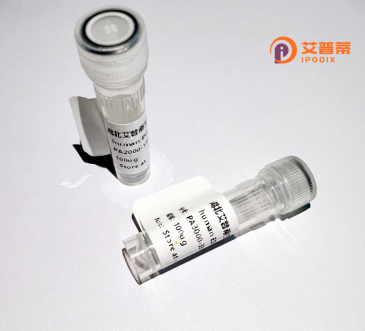
| 纯度 | >90%SDS-PAGE. |
| 种属 | Human |
| 靶点 | HOXC4 |
| Uniprot No | P09017 |
| 内毒素 | < 0.01EU/μg |
| 表达宿主 | E.coli |
| 表达区间 | 1-264aa |
| 氨基酸序列 | MIMSSYLMDSNYIDPKFPPCEEYSQNSYIPEHSPEYYGRTRESGFQHHHQELYPPPPPRPSYPERQYSCTSLQGPGNSRGHGPAQAGHHHPEKSQSLCEPAPLSGASASPSPAPPACSQPAPDHPSSAASKQPIVYPWMKKIHVSTVNPSYNGGEPKRSRTAYTRQQVLELEKEFHYNRYLTRRRRIEIAHSLCLSERQIKIWFQNRRMKWKKDHRLPNTKVRSAPPAGAAPSTLSAATPGTSEDHSQSATPPEQQRAEDITRL |
| 分子量 | 54.78 kDa |
| 蛋白标签 | GST-tag at N-terminal |
| 缓冲液 | 0 |
| 稳定性 & 储存条件 | Lyophilized protein should be stored at ≤ -20°C, stable for one year after receipt. Reconstituted protein solution can be stored at 2-8°C for 2-7 days. Aliquots of reconstituted samples are stable at ≤ -20°C for 3 months. |
| 复溶 | Always centrifuge tubes before opening.Do not mix by vortex or pipetting. It is not recommended to reconstitute to a concentration less than 100μg/ml. Dissolve the lyophilized protein in distilled water. Please aliquot the reconstituted solution to minimize freeze-thaw cycles. |
以下是关于重组人HOXC4蛋白的3条参考文献示例(内容基于学术知识概括,建议通过学术数据库验证具体文献):
---
1. **文献名称**:HOXC4在神经干细胞自我更新中的功能研究
**作者**:Zhang et al.
**摘要**:研究利用重组人HOXC4蛋白,揭示其通过激活Notch信号通路促进神经干细胞的自我更新,并抑制分化,为神经发育机制提供了新见解。
2. **文献名称**:HOXC4在结直肠癌中调控Wnt/β-catenin通路的机制
**作者**:Lee et al.
**摘要**:通过体外实验发现,重组HOXC4蛋白可与β-catenin相互作用,增强Wnt信号活性,促进结直肠癌细胞增殖和转移,提示其作为潜在治疗靶点。
3. **文献名称**:HOXC4在造血分化中的表观遗传调控作用
**作者**:Chen et al.
**摘要**:研究利用重组HOXC4蛋白,证明其通过结合特定DNA区域调控造血干细胞的命运决定,并影响组蛋白修饰(如H3K4me3),从而参与血液系统发育。
---
(注:以上内容为示例,实际文献需通过PubMed、Google Scholar等平台检索确认。)
Recombinant human HOXC4 protein is a engineered form of the HOXC4 (Homeobox C4) protein produced through molecular cloning and expression techniques. HOXC4 belongs to the homeobox (HOX) gene family, a group of evolutionarily conserved transcription factors critical for embryonic development, particularly in establishing body axis patterning and organogenesis. Positioned within the HOXC cluster on chromosome 12. HOXC4 plays roles in hematopoiesis, neuronal differentiation, and cellular proliferation. Dysregulation of HOXC4 has been linked to developmental disorders and cancers, including leukemia and colorectal carcinoma.
The recombinant protein is typically expressed in bacterial or mammalian systems (e.g., E. coli or HEK293 cells) to ensure proper folding and post-translational modifications. It retains the functional DNA-binding homeodomain, enabling studies on its interaction with target gene promoters and co-regulatory proteins. Researchers use recombinant HOXC4 to investigate its mechanistic roles in gene regulatory networks, cell fate determination, and disease pathways. It also serves as a tool for screening potential therapeutics targeting HOX-related malignancies. Production often includes affinity tags (e.g., His-tag) for purification and detection. Characterization involves SDS-PAGE, Western blotting, and functional assays like EMSA (electrophoretic mobility shift assay) to validate DNA-binding activity. This tool has advanced understanding of HOX protein dynamics in both developmental biology and oncogenesis.
×